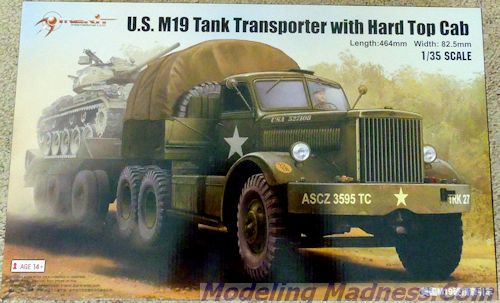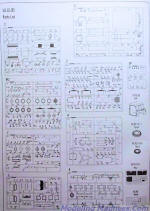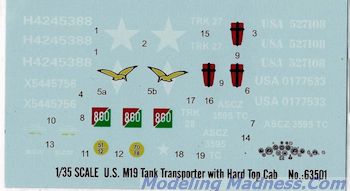
| KIT #: | MRT63501 |
| PRICE: | $150.00 SRP |
| DECALS: | Two options |
| REVIEWER: | Donald Zhou |
| NOTES: | First kit of this vehicle in this scale in normal plastic. Extremely detailed assemblies. Numerous small parts. |

| HISTORY |
After the first tank rumbled into battle in WW I, a problem soon arose in how to
transport them to the battlefield or where they were needed. This is not just
because the first tanks were slow as molasses, but also, they are prone to
breakdown and a force march would usually wear most of them out even before the
battle began. The British tend to transport their big “Marks” on rails but the
smaller French FT’s were easily able to be transported by trucks. This problem
were compounded in the intervening years not just because of the growing weight
of the tanks, but also, during WW I, it was discovered that many of the damaged
or knocked out tanks, if they were towed back, can be fixed and even if not,
many of the parts can be salvaged and quickly distributed to needed crews.
Destroying the said vehicles because of no other options proved to be a very
expensive proposition. This is why men like Christie proposed “self-deploying”
vehicles that can be run on wheels at 80 MPH, and when in battle, tracks can be
directly attached.
But still, as the weight of tanks kept growing, the call for specific tank
transporters/wreckers kept on going out. The British, who built their own
Scammel tank transporters (capable of transporting 20 and later 30 tons),
eventually went to the U.S. and called for various companies to design and build
them a transporter capable of transporting at least 40 tons minimum. Diamond T,
a Chicago based company answered the call.
The resulting vehicle was the Model 980, a 6x4 vehicle capable of hauling 12
tons on its own. It was diesel powered and had a four speed constant mesh
transmission coupled to a 3 speed auxiliary gear box capable of towing at least
40 tons. Although with 40 tons behind it, its top speed was only slightly above
20 MPH and it guzzled 1 gallon of diesel per 2 miles. However, with four huge, 2
on each side, gas tanks, it was up to the task.
This vehicle first appeared in1940 and the U.S, Army quickly adapted it and with
slight modifications, fully satisfied the British requirements also. The vehicle
became known as the M20 Truck, 12 Tons, 6X4. The specifically designed trailer
became known as the M9 45 tons trailer. Combined together, they became known as
the M19 Tank Transporter. Overall, over 5000 of these vehicles were produced
from 1941 to 1945, with the British receiving over 1000 of them. There were two
versions, Model 980 and 981 depending on the winch arrangement and some later
build versions had the much more powerful Hall-Scott gasoline engine in place of
the Hercules engine. Also, in order to save time and money, a “soft cab” (canvas
covered) version were also produced.
Overall, the M19 gave great service throughout the war. However, as one of the
earlier tank transporters, several problems quickly presented themselves. For
example, one of the things it got right was it carried a winch system on the
back if it is used as a wrecker. However, once it became a tank transporter, and
a flatbed is attached, the winch is blocked and the crew had a hard time using
it to get disabled vehicles onboard the trailer. The other big problem, as a
6X4, especially with over a 30 ton load, it had no off road capabilities
whatsoever. With these lessons learned, the U.S. Army soon went out and called
for a new tank transporter in 1942. This eventually became the famous M26
“Dragon Wagon”.
Despite the fact it was replaced in the tank transporter role by the Dragon Wagon, the M19 served throughout the war as a transport for many other vehicles and heavy loads, including pictures showing them transporting various landing crafts in support of Monty’s crossing of the Rhine. After the war, many surplus M19’s were quickly sold beyond cheap as part of the MAP, Military Assistance Program. The Israelis, always short on just about everything during those days, quickly grabbed many of them and pressed them into service. These M19’s were used all the way up to the 1973 Yom Kippur War! Meaning these vehicles were in service long after it was supposedly be replaced!
| THE KIT |
 About
35 years ago, Matchbox released a M19 in the 1/76 scale. Throughout the years,
various resin versions of this vehicle were available. But like any resin kits,
they are hard@$$ to build and expensive as heck. This new kit from Merit
International beats the Matchbox version on everything except price and beat the
resin ones on everything!
About
35 years ago, Matchbox released a M19 in the 1/76 scale. Throughout the years,
various resin versions of this vehicle were available. But like any resin kits,
they are hard@$$ to build and expensive as heck. This new kit from Merit
International beats the Matchbox version on everything except price and beat the
resin ones on everything!
The thing is though, this kit was supp osed
to be released through Hobbyboss as a partner to their massive M1070+M1000 HETS
kit (It was announced during Nurembug 2013 it will appear under the Hobbyboss
label). So how did it turned into a Merit kit instead? The answer is simple. You
see, Hobbyboss and Trumpeter is owned by the same company, Wasan Plastic co. of
China. And Wasan have been using Merit as a distributor for years. When Merit
started to foray into distributing model kits under their own name, they
approached Wasan for some kits. The first of these was the 1/200 USS Hornet,
which was supposed to be released under the Trumpeter label before it was handed
over to Merit. Now the same thing basically happened to this kit. So basically,
this is a “Trumpyboss” kit!
osed
to be released through Hobbyboss as a partner to their massive M1070+M1000 HETS
kit (It was announced during Nurembug 2013 it will appear under the Hobbyboss
label). So how did it turned into a Merit kit instead? The answer is simple. You
see, Hobbyboss and Trumpeter is owned by the same company, Wasan Plastic co. of
China. And Wasan have been using Merit as a distributor for years. When Merit
started to foray into distributing model kits under their own name, they
approached Wasan for some kits. The first of these was the 1/200 USS Hornet,
which was supposed to be released under the Trumpeter label before it was handed
over to Merit. Now the same thing basically happened to this kit. So basically,
this is a “Trumpyboss” kit!
This version of the kit depict one of the original Model 980 trucks with the
single aspect winch, the hard top cab and the Hercules DXFE diesel engine. A
soft cab version will be available later on.
Upon opening the medium sized box (For armor guys, this box is big. But for a
guy who already built a lot of 1/32 scale aircrafts and is still working on that
BBBIIIGGGG 1/200 Missouri, this box is actually kind of disappointingly small),
one is greeted with god knows how many sprues, many of them packaged in
styrofoam to protect some of the smaller parts from breaking (first clue this is
actually a trumpyboss kit). The kit also contains a one piece trailer bed and
cab. These, along with god knows how many wheels, for both the truck and
trailer, a length of string, clear parts and photo etch frets are packed in a
small box in the center of the box (another clue). In fact, for anyone who build
more than one Trumpyboss kit, this should look all too familiar…
The kit starts with the big Hercules engine. Over 77 parts covering 2 pages are
needed to build the engine sans support, some pipes and exhaust pipe that runs
from the front all the way through the rear bumper. A little note, the word
“Hercules” is misspelled as “Hercleus” on the exhaust pipe. An all too obvious
effort to placate corporate greed that’s all too prevalent these days. However,
it’s a shame cause in the end, with the hood covers down, the engine can’t be
seen even through the well hollowed out vents on the covering sides. However, it
looks like the coverings are held in place by the cab and the wheel wells so
with some work, you may not need to cement them in place.
The rest of the truck build up then starts with the frame. This is a multi-piece
affair so obviously, care is needed during the assembly with constant dry fit
and checking whenever possible so all 10 wheels will eventually sit on the
ground when all is said and done. This will take you through most of the steps
before you reach the cab assembly. It might be a good idea to leave the wheel
assembly off to make painting easier. The wheels are not designed to be moved
after finishing. But a careful work around will solve that problem. But it
should be noted that even if the tire spins, the front part of the wheels will
not! But it should make weathering easier. The leaf spring suspensions comes in
two pieces, meaning there will be a seam down the middle when done but the good
news is, all the ejector pin marks will be hidden. Same with the fuel tanks,
which are also in two parts each. However, Trumpyboss designed the seam to
appear on top and bottom. The bottom will disappear once they go on the support
and the top will be hidden when the two photo-etch covering is added.
The flatbed is next. This is actually called the “ballast body” since when
towing a heavy tank, this is usually loaded with heavy objects such as stones,
big huge rocks, or even salvaged tank armor to weight down the rear wheels so
they don’t skid and slide when towing a heavy load.
The cab is the final assembly. Two seats and all the levers, petals and good
steering wheel assembly is provided. Now the doors have both the door lever and
the window control lever. The windows can be added for closed or not for open
window version. I suggest leaving the windshield wipers and especially those two
rear view mirrors off until the end unless you have a real dire need to feed the
carpet monster!
This pretty much finish off the truck. The trailer covers the remaining six
pages or so and is a lot simpler to finish than the truck (I think many will
start with the trailer instead because of this reason). A note. There are four
wheels/tracks blockers/chocks. If you are going to put a load on the trailer,
then the two rear ones should not be put where they are as called on the
instruction. Fill the holes and cut off the locator pins and then insert them
under the tread or wheels of the load. Two loading ramps are provided. Careful
reading of the instructions and judicious use of the cement will make sure these
will be operational
 when
done. After all of this is done, the trailer is then hitched up to the truck
with parts B62 and B15. Personally, I will not add B15, the top part of the
truck hitch for the simple fact this will make transporting the truck and
trailer a lot easier!
when
done. After all of this is done, the trailer is then hitched up to the truck
with parts B62 and B15. Personally, I will not add B15, the top part of the
truck hitch for the simple fact this will make transporting the truck and
trailer a lot easier!
Two marking are provided. One an unknown British units painted in U.S. medium
green with two U.S. Army stars on the sides (probably so some itch twitchy
Yankee pilot don’t shoot them in a friendly fire incident). The U.S. marking is
for the ASCZ, The Advanced Section Communication Zone, aka, the famous “Red Ball
Express” for the 3595 Transportation Company, vehicle 27.
| CONCLUSIONS |
A stunning model of a rather large vehicle that’s in the same class as Tamiya’s Dragon Wagon, 15 ton halftrack SdKfz 9, and Hobbyboss’s M1070+M1000 HETS no matter which label it is under.
July 2014 If you would like your product reviewed fairly and fairly quickly, please
contact the editor or see other details in the
Note to
Contributors.